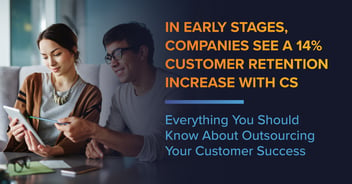.jpg?width=1160&name=GettyImages-1193383274%20(1).jpg)
When validating sales prospects, you want to make sure that pursuing a potential prospect will yield profits. To determine the potential returns from any new lead, you must start by calculating the customer acquisition cost (CAC).
“But how?” you ask. Don’t worry—we will get there.
Once you have determined the CAC, you can match it to the potential profits from that customer based on lifetime value (LTV).
When faced with productivity goals and sales quotas, it’s easy to lose sight of long-term revenue goals. Without calculating customer acquisition costs first, you don’t have a context to estimate profitability. That’s why you need to calculate the overall value or LTV of the customer compared to the initial CAC investment. Spend too much time and resources on CAC, and it will cut into your overall profits.
What is customer acquisition cost?
CAC is simply the cost related to acquiring a new customer. When calculating CAC, you are looking for the end-to-end cost to acquire a lead and convert that lead to a customer. Since CAC starts with the cost of lead acquisition, the sales team must work with marketing to develop a CAC formula.
The equation you use to calculate CAC is simple:
Customer Acquisition Cost = Sales and Marketing Expense/Number of New Customers
The factors that contribute to CAC expenses mostly have to do with marketing efforts for lead nurturing and qualification. CAC expenses include the cost of paid marketing and sales staff, the cost of marketing campaigns (advertising, direct marketing, PPC, and so on), and the cost of lead nurturing (converting prospects into leads).
CAC is the metric that you can use to support your sales strategy. The lower your CAC, the more valuable your customers are. Similarly, lowering your CAC can increase the size of your potential market. If you can acquire qualified leads for less, then those leads can have smaller budgets and still yield reasonable returns.
Calculating CAC also simplifies decision-making. For example, if you target buyers with three different pay-per-click campaigns and generate 100 clicks that yield 10 leads, that seems like a good ratio. If you look more closely and start allocating marketing spend based on the cost per click, you may find the CAC varies. As an example:
- Campaign 1 – 100 leads, 10 customers, CPC is $5, CAC = $50
- Campaign 2 – 100 leads, 10 customers, CPC is $7.5, CAC = $75
- Campaign 3 – 100 leads, 10 customers, CPC is $10, CAC = $100
Campaign 1 clearly outperforms the other two campaigns and yields the lowest CAC.
This is a very basic example, but you can extrapolate costs using all the factors that go into lead qualification and conversion. For example, lead nurturing can affect CAC. Low-touch lead qualification using self-service campaigns and content marketing is less expensive than high-touch lead qualification that requires cold calling and personal qualification. If you can lower the cost of lead nurturing, either using better self-service tools or outsourcing lead qualification to a less expensive resource, you can lower the CAC.
How do you calculate CAC against LTV?
Now consider CAC in the context of LTV. If your LTV is higher, you can spend more on CAC.
For example, you can afford to spend more on lead nurturing for enterprise sales versus SMB sales because the enterprise contract is larger. Enterprise sales tend to be high-touch and more expensive, but the LTV justifies the higher CAC. With SMBs, the LTV is often short so reducing CAC is to your advantage.
When calculating LTV, you want to include various factors that define customer value:
- Average customer life span: How long will you likely be able to retain the contract?
- Rate of customer retention: How many customers buy again?
- Average profit margin per customer: What is the average profit you can expect from each customer, cost of goods, operating costs, and so forth?
- Average gross margin per customer: You can calculate the percentage based on a finite time such as a year or the customer lifetime by taking the profit margin and dividing by 100.
When you match the CAC to the LTV, you can see the true value of each incoming lead. You want the cost of lead acquisition and conversion to balance out with the profits you can expect from the sale over the life of the customer.
What are some ways to reduce customer acquisition costs?
By controlling the variables that affect CAC, you can control the cost of the overall sale, which has a direct impact on LTV. To determine how to lower your CAC, consider each of the factors that go into lead qualification and conversion:
- Marketing expense: As seen in our example above, you can experiment with different marketing strategies but measuring the results is essential. Without metrics, you can’t calculate CAC and see what’s working.
- Conversion rates: Lead qualification rates are a good place to start, but it’s conversion rates that count. Be sure to calculate the value of a lead conversion from start to finish. The cost to convert a lead to a prospect is one thing, but how many prospects become customers? What is the LTV of those customers?
- Time: As the saying goes, time is money—especially in sales. How long does the lead development process take, and how many touchpoints are needed? The longer it takes and the more touches, the more expensive the CAC.
- Personnel costs: What are you paying staff to support lead qualification? If qualified leads are being generated by an automated content marketing program, that’s less expensive than paying sales reps to manually qualify leads.
- Churn rate: Your churn rate has a direct impact on LTV. Lowering your churn rate also lowers your CAC requirements. As the saying goes, it’s much harder to find a new customer than to keep one.
- Upsell and cross-sell: If you can increase the value of customers by selling them more goods and services, that increases LTV, which justifies a higher CAC.
Everything related to customer acquisition has a cost, which ultimately has a direct impact on LTV. The more control you can impose on CAC, the easier it is to manage overhead and project revenue.
There are ways to control each of these CAC cost factors. For example:
- Automate marketing campaigns to cut lead qualification and conversion costs.
- Reduce personnel costs by outsourcing lead qualification.
- Shorten the time in the sales funnel by quickly qualifying leads and reducing the number of touchpoints.
- Prequalify prospect spend, especially with SMBs, to ensure they have a big enough budget.
- Get the right assistance with closing the sale, such as sales engineering support, to shorten the time to close.
- Engage customer success to reduce churn, including outsourcing, onboarding, and Customer Success services.
One way to reduce CAC and simplify your CAC calculations while improving customer acquisition, qualification, and LTV is with outsourcing. Outsourcing reduces CAC by engaging a sales-as-a-service provider that is not part of the company’s overhead. Outsourcing is more efficient and cost-effective, and the costs are easier to control. An outsourced service provider has the technology tools and the staff to manage lead acquisition and conversion, and they can provide the metrics to show you how the program is performing, including CAC costs.
Download our e-book, Is Outsourced Inside Sales Right for You? to learn more about outsourcing customer acquisition and how MarketStar can cut your CAC costs.







